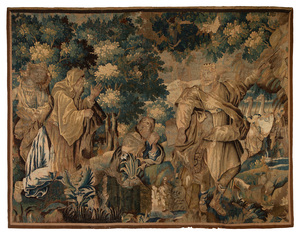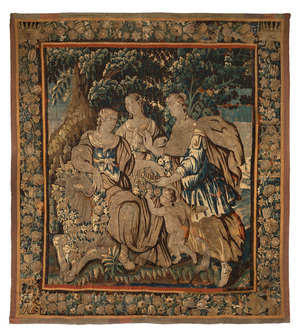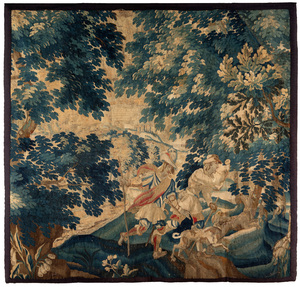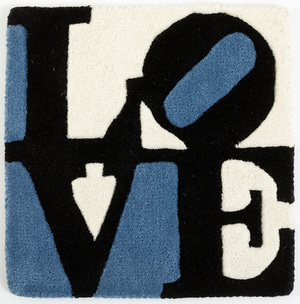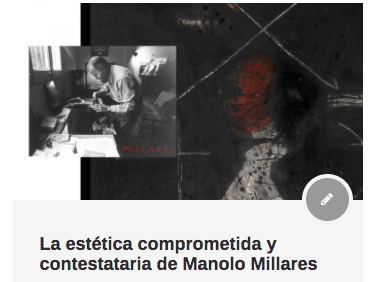The art of tapestry; weaving history.
Considered one of the oldest decorative arts, its relative fragility and the difficulty of its creation have turned this art into a symbol of quality and wealth. Considered luxury objects, tapestries still have a strong presence in the art market today and are highly valued and sought after by collectors.
To think of tapestry is to take a journey through the history of art, tradition and craftsmanship. Its functional character, designed to protect from the cold and humidity of the great walls of castles and fortresses, has never been at odds with a careful aesthetic taste, a characteristic that has elevated tapestries to the category of art, thus arousing the curiosity of great artists who immortalized their works on the fabric.
On September 14, Setdart, features two masterpieces of tapestry art, both from Aubusson, a French municipality with a long tapestry-making tradition dating back to the 16th century. Over the centuries, this area has become, due to its quality, one of the reference centers for the creation of tapestries. It is the only place in the world where all the trades related to the manufacture of tapestry converge in the same space, from obtaining the raw material to the sale. In addition, Aubusson has a Museum dedicated to tapestry and in 2009 it was declared Intangible Cultural Heritage of Humanity.
France, a leading country in the creation of tapestries, had numerous manufactories spread throughout its territory. One of the most appreciated factories was Gobelins, located in Paris and linked to royalty. His production became famous for the use of scarlet red. Founded in the 15th century, the Gobelins workshop achieved a great mastery of color, bringing nuances in the dyes of silk and wool, which brought these materials closer to the qualities of painting. Surviving all the events of France’s turbulent history, the manufacture is still alive today.
French workshops, such as the aforementioned manufactories or those of Beauvais and Arras, competed with the deep-rooted tradition of craftsmanship in the Low Countries. In the 16th century, Brussels and Antwerp became the two most important cities for tapestry making. In addition, Antwerp became the largest center for the commercialization of tapestries, distributing them throughout Europe. The style of this area managed to spread rapidly thanks to the political and economic relations with the Spanish Crown and the size of the kingdom. This school stood out for the use of high-wrap tapestries, which allowed the creation of large works and were characterized by the presentation of the scene within a large frame simulated in the tapestry itself, decorated as a border with fruits, flowers and elements inspired by classical antiquity. In the 17th century, its popularity declined and in the 18th century, tapestry manufacturing ceased in this area.
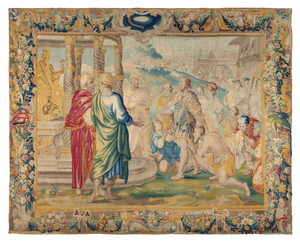
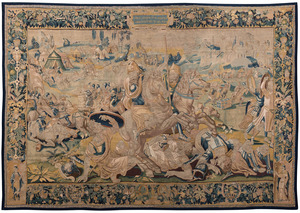
The upholsterer’s trade, highly valued in antiquity, has survived time and has been maintained over the centuries without losing its essence. This discipline has preserved the know-how and the guild structure, differentiated by different schools and regions, which brought technical and stylistic innovations to the art of tapestry. The cartoons of Rubens, for the series “The Triumph of the Eucharist”, destined for the Monastery of the Descalzas Reales in Madrid, “The Acts of the Apostles”, painted by Raphael and of course the cartoons of Goya, have turned the art of tapestry into an attractive discipline for the geniuses of art, who worked collaboratively with the master tapestry artists. In fact, it is said that, in the early days of the master, Goya at the Royal Tapestry Factory, formerly known as the Santa Barbara Factory, was at odds with the upholsterers, since his preparatory cartoons presented a very fluid brushstroke where the tones were not clearly delimited, so that the upholsterers could not follow the drawing with total fidelity, due to the three-dimensionality of the thread.
The history of tapestry is long and, in parallel to that of painting, it has been able to rejuvenate itself and adapt to modernity thanks to the work of tapestry artists and the incursions of artists such as Braque, Joan Miró, with his famed “Tapís de Tarragona” created in 1969. o Robert Indiana (Lot: 35222965). Today, artisans continue to keep the tradition alive and make it accessible to the public, thanks to workshops such as the Real Fábrica de Tapices, located in Madrid, or the Casa Aymat in Barcelona.

